Hybrid vs. Remote Work: Which Is Better? What Is The Future?

The pandemic has revolutionized many people’s way of thinking. It made us change our habits and taught us to adapt and observe the norms of social distancing. Most businesses started considering not just remote work but hybrid as well. Telework existed before the pandemic, but many companies were reluctant to take this step.
The move to the remote work model was different for everyone. Some faced frustration due to the changed routine and the inability to cope with stress. Others have finally enjoyed the increased freedom to plan their schedule. However, the quarantine is loosening its grip now. People are getting vaccinated, and life is returning to its former state. Or almost.
The moment has come to get back to the office. But not everyone is ready (or happy) to do it again. That’s why some companies keep the work-from-home approach or encourage remote or hybrid work.
How do these terms actually differ, and which one suits your business? Read this article to resolve the hybrid vs. remote work battle and find the perfect solution for your employees.
Hybrid vs. Remote Work: Do Employees Want To Return To The Office?
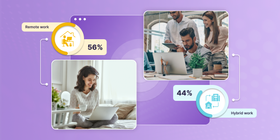
So, the day came when people found themselves at home. They had only laptops/PCs to perform work tasks, shop, and communicate. The increased online traffic encouraged companies to modernize their websites. This ensured a flawless user experience and the adoption of entirely new paradigms, such as the headless commerce approach.
What is remote work?
It’s the practice of performing tasks outside the office environment. Technically speaking, there is a slight difference between remote vs. virtual work — the former may involve work that is not tied to an electronic device, such as field sales. But the terms are very often used interchangeably. One of the biggest problems with this setup is that it’s difficult to regulate.
As more restrictions are lifted, employees may choose the workplace they like. They can work from cafes, libraries, coworking spots, etc.
Why do people such places attract people more than on-site work? Is there a big difference between working from home vs. office?
Many employees have redesigned their processes. As such, workplaces have learned to cope with household distractions. For some, switching to a new norm was a stressful experience, and they didn’t want to repeat it. Others appreciated the benefits of telework. That’s what the Upwork study of 1,000 small businesses discovered:
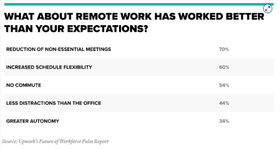
Screenshot taken from the official CNBC website
With the reduction of non-essential meeting room meetings, time to commute, and time wasters, workers have more time to focus on their duties. This boosts the productivity of remote teams and increases the number of finished tasks. People can also plan their schedules and pick the perfect location with the most productive atmosphere. A relaxed state of mind in the comfort of the home nurtures creative ideas.
According to a Bloomberg study, 39% of 1,000 surveyed employees would instead leave if their managers insisted on returning to the office. However, remote work has numerous disadvantages, which we’ll discuss further. And it may be crucial for you to have in-person interaction or rent an office space.
How do you retain employees and find a middle ground? That’s where hybrid work may come in handy.
What is hybrid remote work?
A hybrid work environment is when a company lets employees choose when to come to the office and when to stay at home. Another variant is when certain days are fixed for teams/team members. For example, marketing and sales departments should work in the office on Monday, Wednesday, and Friday. IT office schedules on Tuesday, Wednesday, and Thursday.
Are hybrid schedules better than an entirely remote approach? Let’s compare the remote work vs. hybrid options.
3 Reasons Remote Work May Not Be the Perfect Solution
As technologies evolve, businesses with physical offices don’t have to keep workers on-site. Task and time management tools let you monitor the activity of employees and assign tasks without meeting in person. Nevertheless, remote work doesn’t fit everyone. And below are the reasons why.
1. It’s Harder To Separate Responsibilities From Leisure Time
Many statistics point to the increased productivity of fully remote workers. But it doesn’t mean they start to get more things done faster. In most cases, employees begin the workday earlier and close their laptops not long before falling asleep. They feel like they are always at work without the much-needed switch to the post-work relaxation mode.
Such an arrangement blurs the line between working hours and leisure. That’s why remote employees may have issues unplugging from work and spending time with their families. It has long-term consequences, such as higher burnout and job attrition risks. What the pandemic taught us is that health and quality time is key. So, you’ll have to devote time to uncover disturbing symptoms even if employees are out of sight.
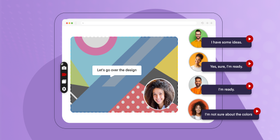
2. The Inability To Chat With Colleagues
When you’re in the office, it’s easy to come up to your colleagues and communicate. Lunches, coffee breaks, and other activities nurture a feeling of being connected to your team. You can also ask someone about work-related issues and get an instant reply.
Remote work limits the ability to converse with colleagues. While you may chat with them on messenger apps, these are more formal conversations. They are without essential eye contact, facial expressions, and others. Employees may end up feeling disconnected and alone.
3. Greater Need For Self-Discipline
Procrastination becomes an urgent issue because you don’t have any supervision at home. You may get distracted by everything:
- household chores
- screaming children
- a barking dog
- the need to take care of relatives
- social media notifications
Remote employees should also deal with disruptions, such as power outages, a PC/laptop not working, or a virus spreading on their devices. These factors take a toll on individuals’ productivity. Plus, it’s harder for managers to coordinate remote workers and ensure everyone’s using their work hours properly.
Hybrid Work: The Benefits Of Remote And In-Office Work Combined

According to PwC, 83% of employers consider the shift to remote work to be a success. Nevertheless, the office will stay. Some people need this office atmosphere with direct communication. Having a quiet place with a comfortable chair, table, and AC also positively impacts productivity.
That’s why a remote hybrid work schedule may be an excellent fit for those who want agility and in-office productivity. Here is what the same report says about the number of days executives expect employees to come to the office:
- 29% of respondents want to see employees on-site three days a week.
- 21% of executives consider five days per week in the office ideal for keeping a strong culture.
- 18% agree on four days a week in the office.
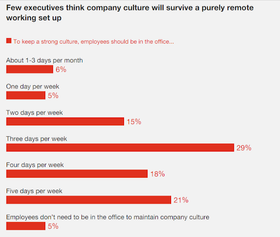
Screenshot taken from the official PwC website
1. Picking the Most Productive Place and Time
An office-first model involves strict rules on when employees should be present. It’s usually between 9 am and 5 pm every workday. A hybrid model relies on the work done rather than the hours spent in the office. Employees can work when they are at the peak of their efficiency. For example, they can have an offline meeting in the morning and finish heads-down tasks in the evening at home.
This autonomy, an essential part of a remote work culture, involves a great level of trust between team leaders and subordinates. It is beneficial for relationships in a team. Enhanced productivity and empowerment also lead to employee satisfaction.
2. More Opportunities to Collaborate
A hybrid model preserves the benefits of face-to-face communication and collaboration. What does it entail? Productivity, engagement, and stronger relationships.
You may have heard about the term “Zoom fatigue”. Also known as virtual fatigue, this feeling of exhaustion emerges after having an online conference or call. The more employees conduct them, the closer they get to burnout.
That’s why a venue to socialize in person may have a beneficial long-term effect. Offline activities, such as daily meetings and team building, are crucial for building loyalty to a company, its members, and its goals.
3. Better Mental Health for Everyone
The transition to telework has brought mental benefits for many employees. The new norm allowed them to manage the day as they wished to, saving time on commuting to work. They also didn’t have to stay in the office to finish the task and meet the deadline, negatively impacting their family relationships. Work from home also freed up time to self-educate, take up a sport, or improve health.
Nevertheless, others felt isolated compared to the times in the office. They got snowed under the pressure of having one place for work and leisure. A hybrid work model is an ideal solution to satisfy both groups of remote and in-office workers. It lets them have a healthier work-life balance depending on where they perform best. And positive mental outcomes lead to satisfaction, loyalty, and productivity.
Hybrid vs. Remote Work: Who Is the Winner?
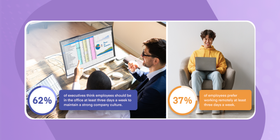
What should you choose in the debate over hybrid vs. remote work? The winner depends on your goals and whether you can rent an office.
In my opinion, a hybrid model will be the trend shaping the workplace in the future. Why? Because it provides the benefits of in-person communication and telework. If you can rent an office, it’s better to gather your employees under one roof while giving them the freedom to stay at home on certain days.
In any case, both options will stay with us in 2025 and beyond. Just look at the statistics below. It’s a McKinsey & Company report showing the percentage of people with the preferred working models. The numbers have increased before the COVID-19 pandemic and after:
- from 30% to 52% for a hybrid
- from 8% to 11% for entirely remote
The preference to work full time on-site dropped from 62% to 37%.
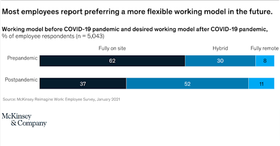
Screenshot taken from the official McKinsey & Company website
Conclusion
Does your company need a more flexible working arrangement? Consider remote vs. hybrid work, and at least allow people to choose when to stay at home. Both models significantly contribute to:
- achieving innovation
- attracting the finest personnel
- producing benefits for everyone
These relatively new working approaches positively impact businesses, workers, and the environment. For example, they reduce the cost and time to drive to the office. They sustain healthier relationships within the workplace. They let people plan their work rather than squeeze home activities into the time after leaving the office.
Companies become less dependent on location. Thus, you can hire specialists with the needed qualities at attractive rates regardless of their residence. What can a business do to embrace these trends? Ensure sound policies, open communication, and a clear structure that prioritizes equity.
References And Further Reading
- How to Manage a Remote Development Team Without Stress
- Managing Remote Teams Today: Top 3 Challenges, Tools & Tips
- How to Keep a Remote Team Connected and Create a Happy Workplace
- Future of Work: Trends That Will Shape the Workplace in 2025
- 1 in 4 Americans Will Be Working Remotely, Upwork Survey Reveals
- Employees Are Quitting Instead of Giving up Working from Home
DON’T MISS OUT
Get updates on new articles, webinars and other opportunities: